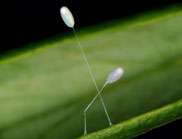New thread in fabric of insect silks

(PhysOrg.com) -- The aptly named silk worms long appeared to have the monopoly on insect silk production, but now scientists are revealing that the world of insect silks is highly complex.
Not only do different insects produce different silks but individual species can produce more than one type of silk.
CSIRO scientists have just revealed their findings on the rare and fascinating silk that lacewings use to make their egg stalks - a cross-beta silk.
“We have identified and sequenced the genes for the egg stalk silk of adult females of a common Australian green lacewing, Mallada signata,” CSIRO Entomology’s Dr Tara Sutherland said. “We found that the lacewing egg stalk silk contains two fibrous proteins which are folded up like panels in a concertina door.
“The silk in the egg stalk is produced as a liquid and dries in few seconds in air. It is very strong with a high lateral stiffness - nearly three times that of silkworm silk - and remarkable elasticity.”
A female lacewing produces the silk as a drop of liquid which she then draws out. The thread hardens in a few seconds and the female then lays an egg on its tip, protecting the egg against predators.
Dr Sutherland said this is another fascinating insight into the world of biological silks.
Scientists have long sought to produce artificial insect silks. Understanding this lacewing silk brings them closer to achieving their goal.
The lacewing’s silk is produced as a liquid which rapidly solidifies in air, making it easier to produce than through the complex systems of moths and spiders.
Dr Sutherland said that silk production is a multi-step process which involves making the proteins and then fabricating these into the physical structure of silk.
While the silk proteins from bee and ant silks are easier to produce chemically, it is the much simpler way lacewings fabricate their silk that has caught the scientists’ interest.
This lacewing is also a very effective biocontrol agent as its larvae consume, amongst other things, aphids, mealybugs and mites.
More information: Sarah Weisman, Shoko Okada, Stephen T Mudie, Mickey G Huson, Holly E Trueman, Alagone Sriskantha, Victoria S. Haritos, Tara D Sutherland. (2009). Fifty years later: the sequence, structure and function of lacewing cross-beta silk. Journal of Structural Biology, doi:10.1016/j.jsb.2009.07.002
Provided by CSIRO (news : web)



















